 |
 |
 |
| |
Interruption of ART and Changes in Hyaluronic Acid as Marker of Liver Fibrosis Progression in Strategies for Management of ART Viral Hepatitis-co-infected Participants and Matched Controls
|
| |
| |
"HA levels increases temporarily after ART is interrupted. Interruption of ART in chronic viral hepatitis Co-infected persons is particularly dangerous if HA levels just prior to the interruption are elevated."...."Co-infected participants with elevated baseline HA levels (>75 ng/mL) had significantly higher IL-6 and D-dimer levels than those with normal levels (<75 ng/mL), table 2A . Similar trends were also seen in the few HIV monoinfected individuals with elevated HA, table 2B."
Reported by Jules Levin Montreal 2009 Feb 8-12
Lars Peters and for the INSIGHT SMART Study Group
Copenhagen HIV Prgm, Hvidovre, Denmark
Background: In persons co-infected with HIV and hepatitis B or C virus (HBV or HCV), liver fibrosis is accelerated compared to persons infected with hepatitis virus only. Liver fibrosis progression has been correlated to lower CD4 counts in observational studies; we therefore hypothesized that a marker of liver fibrosis-hyaluronic acid-would increase after interrupting vs continuing ART in hepatitis-co-infected but not in HIV-mono-infected participants entering the randomised controlled trial SMART.
Methods: All participants positive at baseline for HCV RNA (HCV+) or hepatitis B surface antigen (HbsAg) (HBV+) and with available plasma samples were included. We included a control group of HIV mono-infected participants, matched on randomization date, gender, age, treatment group, history of alcohol abuse, and number of follow-up samples available. Stored plasma samples were tested for hyaluronic acid (normal range 0 to 75 ng/mL) at baseline and at months 6, 12 (cases only), and 24 during follow-up in the drug conservation (DC; interrupt ART until CD4 <250) group and the viral suppression (VS; continued use of ART) group. Predictors of non-AIDS deaths were assessed using Cox proportional hazards models after adjustment for: treatment group, baseline hyaluronic acid, age, gender, race, prior AIDS, HIV RNA, CD4, nadir CD4, baseline ART status, history of alcohol abuse, and HBV/HCV status.
Results: Of the participants, 675 were co-infected: HBV+ (n = 114, 16.9%), HCV+ (n = 553, 81.9%), and HBV+/HCV+ (n = 8, 1.2%). The median follow-up was 33 months. For the co-infected participants the median CD4+ (cells/mL) count at baseline and month 12 in the drug conservation and viral suppression groups was 599/566 and 415/551, respectively.. The hyaluronic acid levels at baseline was higher in the co-infected than in the controls and increased in the co-infected-but not in the controls-after 6 months of follow-up, but not thereafter (table). In the co-infected group, baseline hyaluronic acid (per 100 ng/mL higher) was an independent predictor of non-AIDS-related death (31 deaths [2 liver-related]; HR 1.2, 95%CI 1.1 to 1.4).
Conclusions: Interruption of ART led to higher levels of hyaluronic acid in HIV/hepatitis-co-infected but not in HIV-mono-infected participants. The higher levels were observed 6 months from study entry but not subsequently, possibly reflecting an acute inflammatory response or liver injury associated with interrupting ART. Additionally, baseline hyaluronic acid was an independent predictor of non-AIDS-related death.
HIV monoinfected controls
A control group of HIV monoinfected participants matched 1:1 on randomization date (+/- 6 months), gender, age (+/- 5 years), treatment group (DC vs. VS), history of alcohol abuse and number of follow-up plasma samples available (controls ≥ cases), was included.
Hyaluronic acid
HA was measured in stored plasma samples at baseline and at month 6, 12 (co-infected only) and 24 during follow-up using a commercial enzyme linked binding protein assay (Corgenix, Colorado, USA) with a HA range in a healthy population between 0-75 ng/mL. Each HA level was measured in duplicate according to the manufacturers specifications. Alanine and aspartate aminotransferase levels as well
as liver biopsies were not routinely performed in the SMART study.
Statistical methods
· Wilcoxon rank sum test was used to compare median change in HA from baseline to month 6 and to compare baseline biomarker levels between DC and VS groups
· Logistic regression was used to model the odds of >72 ng/mL (one standard deviation) change in HA from baseline to month 6
· Time to non-AIDS death for co-infected participants was compared between four groups according to treatment group and baseline HA (≦ or >75 ng/mL using a Kaplan-Meier plot
RESULTS
Baseline characteristics
Out of 5,472 participants enrolled in the SMART from January 2002 - January 2006, 675 were HBV+ or HCV+ and had specimens available for analysis. 110 (16.3%) were HBV+, 553 (81.9%) were HCV+ and 12 (1.8%) were both HBV+ and HCV+. Compared with the HIV monoinfected, the co-infected group was more likely to be of black race (48.4 vs. 34.1%) and less likely to be ART naïve (2.4 vs. 4.3%) and undergoing ART (79.3 vs. 85.8%) and had longer median time since initiation of ART (7 vs. 6 years). The median baseline CD4+ count was high for both co-infected and HIV monoinfected (580 vs. 583 cells/μL), table 1.
Follow-up
The median follow-up was 33 months for the co-infected group and 35 months for the HIV monoinfected controls. Figure 1 shows the changes in HIV-RNA and CD4+ during follow-up in co-infected and HIV monoinfected according to treatment arm. Among co-infected participants 52 (31 in DC, 21 in VS) died from non-AIDS causes, while 29 developed an opportunistic disease. 21 developed a major liver event (17 cirrhosis, 4 liver-related deaths)
HA levels at baseline and during follow-up
Median HA levels and percent with HA higher than the upper level of normal for co-infected and HIV monoinfected are shown in figure 2. By month 6 the DC group of co-infected participants, but not the HIV monoinfected controls, had a significant increase in median (IQR) HA compared to the VS, figure 3. However, this difference was not sustained at month 12 only co-infected) and 24 (data not shown).
HA as a predictor of development of clinical events
In co-infected participants, those with a baseline HA level >75 ng/mL and randomized to the DC arm had a cumulative risk of non-AIDS death of 37.3% after 48 months compared with only 7.3% in participants randomized to the VS arm irrespective of baseline HA level, figure 4. Similar trends, though less striking, were seen for liver-related outcomes.. Baseline HA levels did not predict risk of opportunistic infections [data not shown]. The DC/VS hazard ratio (95% CI) for non-AIDS death in co-infected participants with a baseline HA level >75 ng/mL was [HR 3.8 (1.4-10.6, p=0.009], while for those with HA level ≦75 ng/mL it was [HR 0.9 (0.4-1.8), p=0.76]. P-value for interaction
was 0.02. Only 16 monoinfected participants had a baseline HA >75 ng/mL, precluding an analysis of this group.
Association between HA and IL-6 and D-dimer
Co-infected participants with elevated baseline HA levels (>75 ng/mL) had significantly higher IL-6 and D-dimer levels than those with normal levels (<75 ng/mL), table 2A . Similar trends were also seen in the few HIV monoinfected individuals with elevated HA, table 2B.
SUMMARY
· Hepatitis co-infected participants had higher median plasma levels of HA at baseline and during follow-up than HIV monoinfected
· Interruption of ART was associated with a significant increase in HA levels at month 6 among co-infected participants randomized to the DC arm. This difference was not sustained at months 12 and 24
· Baseline HA was an independent predictor of time to development of non-AIDS death, but not opportunistic disease
· Co-infected participants randomized to the DC arm with a baseline HA level > 75 ng/mL had a 37.5% risk of non-AIDS death after 48 months, whereas the risk was only 5% for those with a baseline HA ≦ 75 ng/mL
CONCLUSION
HA levels increases temporarily after ART is interrupted. Interruption of ART in chronic viral hepatitis Co-infected persons is particularly dangerous if HA levels just prior to the interruption are elevated.
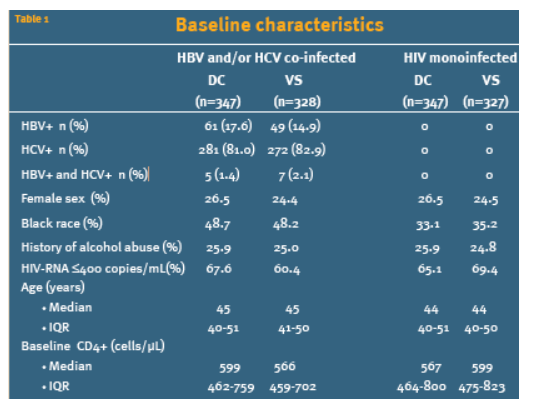
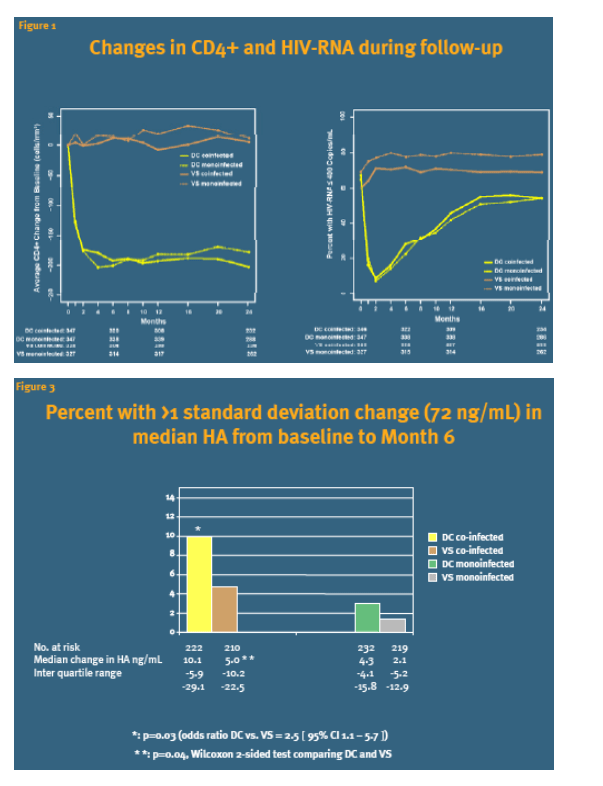
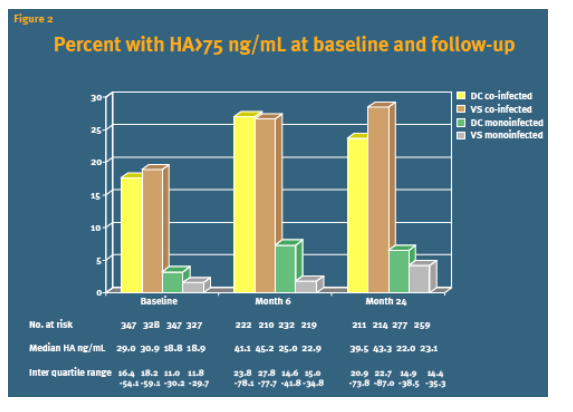
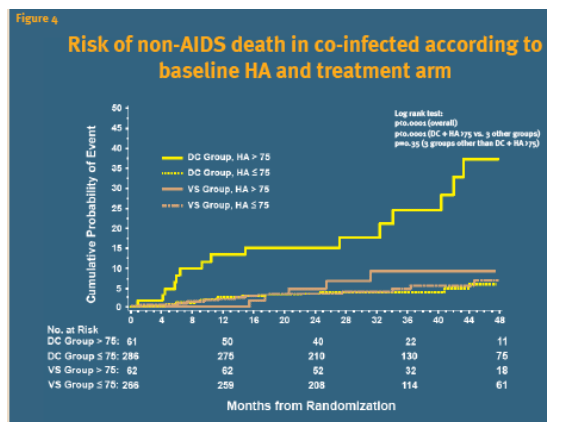
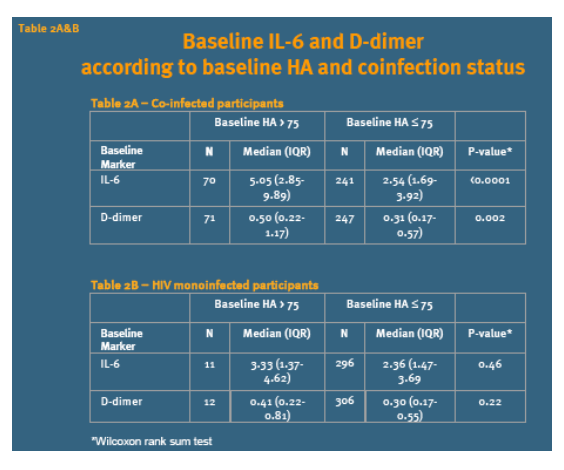
|
| |
|
 |
 |
|
|